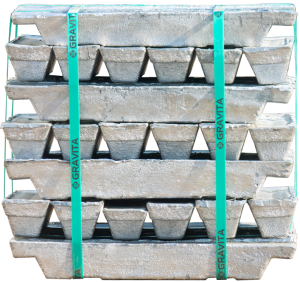Native Lead rarely occurs in nature. It is usually associated with ore with Zn, Ag and Cu, and is extracted together with these metals. The Lead metal is primarily extracted from sulphide ore i.e galena (PbS), which has the 86.6% Lead content. Two other minerals commercially mined for Lead are cerussite (PbCO3) and anglesite (PbSO4). Over 95% of all Lead mined is derived from one of these three minerals. The largest source of Lead, however, is from recycling, & the automobile battery takes the lion’s share.
Name : Lead (Latin: plumbum)
Symbol : Pb
Boling Point : about 1,740°C
Melting Point : 327.5°C
Color : bluish white
Density of solid [kg m-3] : 11340 at 20°C
Classification : Metallic
Solubility : Insoluble in water
Atomic Number : 82
Atomic Weight : 207.2 (1) gm
Conditions to Avoid : Heat, flames, ignition sources and incompatibles
Stability : Stable under ordinary conditions of use and storage
Lead is a relatively soft metal with bluish-white lusture but on exposure to air, it becomes covered by a dull, gray layer of basic carbonate that adheres closely and protects it from further oxidation or corrosion. It has a low tensile strength and a relatively poor conductor of electricity. It has a face-centered cubic crystalline structure. Modern Lead mines produce about 3 million metric tons of Lead annually. This is only about half the Lead used worldwide; the remainder is obtained by recycling. The top producer of Lead is Australia, followed by the United States, China, and Canada. Other countries with major Lead deposits are Mexico, Peru, Russia, and Kazakhstan.
 Lead has the advantages of low melting temperature (327°C) and good malleability, which enable Lead articles to be cast, join & shape easily. The very high density of Lead makes it suitable for shielding against sound, vibrations and radiation, for example as protection for users of computer and TV screens. For these purposes Lead is used in metallic form or as Lead compounds in Lead glasses. Some compounds of Lead have their own useful properties, particularly in relation to color and glass-forming ability.
Lead has the advantages of low melting temperature (327°C) and good malleability, which enable Lead articles to be cast, join & shape easily. The very high density of Lead makes it suitable for shielding against sound, vibrations and radiation, for example as protection for users of computer and TV screens. For these purposes Lead is used in metallic form or as Lead compounds in Lead glasses. Some compounds of Lead have their own useful properties, particularly in relation to color and glass-forming ability.
Categories
Archives
- June 2023
- May 2023
- April 2023
- March 2023
- February 2023
- January 2023
- December 2022
- November 2022
- September 2022
- August 2022
- January 2022
- August 2020
- February 2020
- January 2020
- November 2019
- June 2019
- April 2019
- February 2019
- September 2018
- August 2018
- May 2018
- April 2018
- January 2018
- November 2017
- October 2017
- September 2017
- July 2017
- June 2017
- May 2017
- April 2017
- March 2017
- February 2017
- January 2017
- December 2016
- November 2016
- September 2016
- July 2016
- May 2016
- January 2016
- November 2015
- July 2015
- June 2015
- February 2015
- December 2014
- November 2014
- September 2014
- August 2014
- July 2014
- May 2014
- March 2014
- February 2014
- December 2013
- November 2013
- October 2013
- September 2013
- July 2013
- May 2013
- April 2013
- March 2013
- January 2013
- October 2012
- September 2012
- August 2012
- July 2012
- June 2012
- May 2012
- March 2012
- February 2012
- January 2012
- November 2011
- July 2011
- May 2011
- April 2011
- October 2010
- September 2010
- May 2010
- January 2010
- December 2009
- September 2009
- May 2007

 Pure Lead
Pure Lead Lead Sheet
Lead Sheet